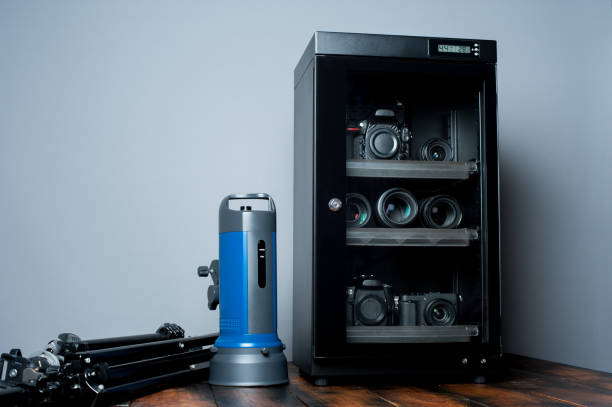Humid air sneaks into camera parts and quietly harms your gear. In sticky climates, moisture clings to every surface and creeps into tight corners. To guard your tools, you must store them in a camera cabinet that shields against dampness. This guide walks you through how to care for cameras in wet weather and what to keep inside a good cabinet.
When you take care of your gear, it rewards you with clean shots, smooth zooms, and crisp focus every time. Prevention always works better than repair.
Humidity Wrecks Camera Gear Slowly
Wet air clutches onto glass, metal, and plastic. Over time, it breeds fungus, rust, and grime. Lenses turn cloudy. Buttons stick. Hinges lose their shine. Dust joins the mess and makes it worse.
Fungus spreads like a slow leak. Rust chews through metal. Once damage shows, it becomes hard to fix. That’s why you must fight humidity before it grabs hold. Skipping protection may cause hidden harm, even when your gear still looks fine on the outside.
How a Camera Cabinet Guards Your Equipment?
A proper camera cabinet traps your gear inside a dry, sealed space. It sucks out moisture and holds the air steady. Inside, tools stay safe and dry. Fungus has no room to grow. Metal avoids rust.
Photographers often place the following inside:
- Cameras and lenses
- Memory cards and batteries
- Filters, cloths, and manuals
This cabinet doesn’t just protect your main gear. It shields every tiny part that matters, including caps, lens hoods, and even cleaning pens.
Aim for the Right Humidity Level
Dry air must stay balanced. Too dry, and rubber or leather cracks. Too wet, and mould grows.
Set your cabinet’s humidity between 35% to 50% RH. This range keeps your gear healthy and steady. Most cabinets show the number with a built-in meter, so you can check it often.
Don’t guess the number. Even a small change in humidity can trigger long-term problems. A few seconds of checking saves years of trouble.
What Makes an Electronic Dry Cabinet Special?
An electronic dry cabinet uses power to pull out moisture and keep the air steady. It works quietly without blowing heat or air. It doesn’t need chemicals or packets. Just plug it in, set the number, and let it run.
Once it starts, it holds the same dry level all day and night. You don’t need to touch it often. It becomes a quiet part of your gear routine—always ready and always running in the background.
Why You Need One in Humid Areas?
In wet weather, you can’t always see the damage building up. Cameras soak in tiny bits of water. Over time, foggy lenses, rusty screws, and fuzzy mould appear.
An electronic dry cabinet for humid environments stops moisture from winning. It pulls water from the air, even when it doesn’t feel wet around you. It helps your gear stay ready, clean, and sharp.
A good dry cabinet:
- Stretches the life of your tools
- Keeps the parts clear and fast
- Saves you from expensive repairs
It also helps keep your kit organised in one secure place.
What to Look for in a Cabinet?
Not all cabinets protect the same way. Some hold better air. Some make storage easier.
Here are the key things to check:
1. Precise Humidity Setting
- Pick a cabinet that lets you choose an exact number, not just “low” or “high.”
2. Tight Door Seal
- Rubber around the door keeps outside air from sneaking in.
3. Humidity Meter
- You need a display that shows the air level inside. Check it weekly.
4. Moveable Trays
- Your gear comes in different shapes. Shelves that slide or shift make space easier to use.
5. Quiet Motor
- You don’t want a loud buzzing sound near your gear. Find a cabinet that hums gently or stays silent.
How to Use a Camera Cabinet the Right Way?
Your cabinet works best when you follow a few smart steps. Don’t just toss gear inside and slam the door.
Follow these steps:
- Wipe the gear dry before placing it inside
- Leave space between items so air flows around them
- Check the number once a week to keep levels safe
Don’t store anything wet inside — even damp straps or bags. Let them dry fully before storing them. Treat your cabinet like part of your camera care routine.
What You Should and Should Not Do?
Good habits help gear last longer. Bad habits let fungus grow and cause trouble.
Do:
- Clean your lenses before putting them away
- Wipe off sweat and fingerprints
- Shift your gear once a week so it doesn’t stick to the tray
Don’t:
- Stuff wet bags or cloths inside
- Leave the cabinet door open too long
- Stack items on top of each other
Even small mistakes add up. Get in the habit of regular checks and quick cleaning.
Compare the Best Features Before You Choose
If you want to buy the right cabinet, look at what each one offers. Use this table to help you decide.
| Feature | What It Does | Why It Helps in Humid Weather |
| Electric Moisture Control | Keeps the air dry all day | Blocks fungus and stops rust |
| Humidity Meter | Shows the air level inside | Helps you know when to adjust it |
| Sliding Trays | Holds different items safely | Avoids crushing or trapping air |
| Door Seal | Stops air from leaking in | Protects the dry inside |
| Quiet Running | Keeps noise low | Won’t shake or disturb your setup |
These features make storage safer and easier. Pick what fits your space and needs best.
Avoid These Common Mistakes
Sometimes people forget how to care for the cabinet or skip steps that protect their gear.
1. Leaving the Door Open
- Moist air rushes in fast when the door stays open. Open it quickly and shut it tight after use.
2. Storing Dirty Gear
- Dust and dirt trap water. They stick to your lens and grow mould. Clean gear every time before storing.
3. Ignoring Humidity Levels
- Don’t forget to check the number. If it goes too high, your cabinet stops protecting your gear. Look once a week to stay safe.
You can also keep a simple reminder note near the cabinet to help you remember.
Clean Your Cabinet Like Your Camera
Dirt builds up inside your cabinet over time. Keep it clean like your lens and body.
Each month:
- Dust the trays and sides
- Wipe the outside glass
- Look at the seals and rubber strips
If your screen turns off or blinks, check the plug or replace the battery. A clean cabinet does a better job. Keeping it tidy also makes your workspace look better.
Final Thoughts
Sticky air harms your camera slowly. It ruins parts you can’t replace. But you can stop it.
A strong camera cabinet and clean habits give your gear a safe home. An electronic dry cabinet guards your equipment day and night without effort. If you live where damp air fills the room, use an electronic dry cabinet for humid environments to fight back.
Protect your tools. Keep them sharp. Let your next photo shine, knowing your gear waits clean, dry, and ready.
FAQ’s
1. Why do I need a camera cabinet in humid weather?
Humid air breeds fungus that grows on camera lenses and sensors. A cabinet keeps your gear dry by controlling moisture levels, so cameras, lenses, and accessories stay safe and last longer.
2. How does an electronic dry cabinet work?
An electronic cabinet uses a dehumidifying unit that removes moisture from the air inside. A built-in meter shows the humidity level, and you can adjust settings to keep your gear in a safe range.
3. What size camera cabinet should I buy?
Pick a cabinet based on your collection. A 30–40 litre cabinet fits one camera and a few lenses. Larger collections need 60 litres or more. Always leave extra space for future gear.
4. How often should I check the cabinet’s humidity?
Check the meter once a week to make sure levels stay between 40% and 50%. Some models even show digital readings. A quick look keeps your equipment safe from unnoticed changes in moisture.



